(This article has been slightly updated since it was originally posted i 2014.)
Canon has released a new ultra-wide zoom lens, the Canon EF 16-35mm f/4 L IS lens.* There has been a lot of excitement about this lens among Canon photographers since it addresses some weaknesses in previous Canon lenses of this type, including the EF 16-35mm f/2.8 L II and the venerable EF 17-40mm f/4 L. Each of those can produce fine photographs, but each also has its issues, mostly related to corner resolution. Early tests of the new 16-35mm f/4 L IS suggest that it performs much better in the corners. (In the first months following introduction, there were some issues with corner performance on some copies, but those have been addressed.) The lens also adds “IS” (image-stabiliztion), which is useful if you use it for handheld photography.
With this in mind, I did something I rarely do, and I purchased a newly-released lens right when it came out. Mine arrived last week, but I did not have a good opportunity to put it to real photography use until several days later when I took it out for a morning of redwood forest photography at the Muir Woods National Monument. (I did snap a few promising handheld shots right after I unpacked it, but such things rarely tell the whole story.) I did something else that is a bit unusual for me — I stuck the ultra-wide zoom on the camera at Muir Woods and shot with only that lens instead of the longer focal lengths that I more typically use.
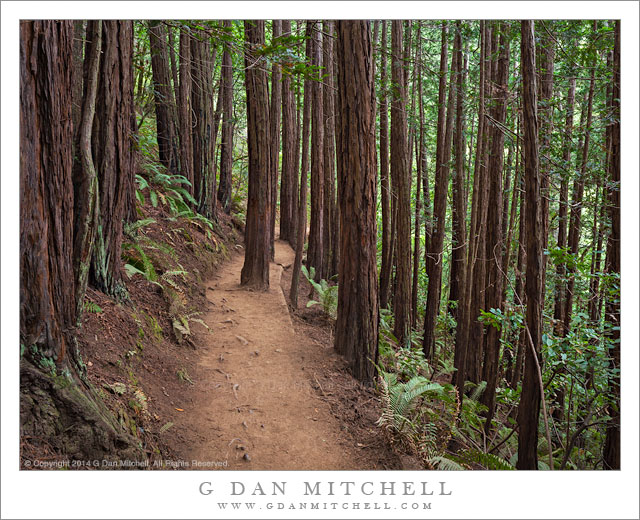
Corner performance has been one of the main issues with the older Canon ultra-wide zoom lenses. The 17-40mm f/4 is known for soft corners at the largest apertures. It is always sharp in the center, but I most often shot mine stopped down, often at f/16 for landscape photography when maximizing depth of field. At smaller apertures the corners improve a lot, but they are never as good as what we see on more recent lenses with short focal lengths. Canon’s f/2.8 16-35 L II starts out fairly well at f/2.8 — in fact, its performance at f/2.8 is arguably its chief virtue compared the previous f/2.8 version — but performance stopped down isn’t any better than that of the less expensive 17-40. The promise of the new 16-35 f/4 lens, and the assessment in many early articles about it, is that it offers significantly better corner performance. Many who used early copies reported that it provides good resolution all the way into the corners, even wide open at f/4 and at all focal lengths. So I wanted to try it out in real-world shooting of the sort I’m most likely to do with such a lens, and see how it stacks up against my 17-40 lens on my full frame camera.
Before sharing the results of my brief “test,” I must point out that I did not conduct what might be regarded as comprehensive objective testing. Doing that would require me to point the camera/lens at an appropriate flat target and to then make a series of exposures at various focal lengths and apertures. Instead, I shot the lens as I typically shoot such lenses. I used shorter focal lengths to include a large area in the composition and to create some “near-far” compositions in which subjects at very different distances require me to stop down to obtain a very large depth of field. Almost all of the shots I made on this day were at f/16, with a few at f/8 thrown in just to see what would happen. On one hand, this is not a very good way to reveal the maximum resolution that a lens can provide. On the other hand, it is the way that most people use ultra-wide zooms! What did I see in the photographs?
- The image quality, particularly in terms of resolution, is very good all the way into the corners. It seems to be especially good for an ultra-wide zoom, a type of lens that often reveals corner performance weaknesses. I shot at focal lengths from 16mm to 35mm and at various points in between. The performance is good across this entire range. The consistency of the image into the corners from this lens is striking by comparison to my 17-40mm lens.
- There was very, very little CA (chromatic aberration) of any type in the raw files. Many lenses, and especially ultra-wides, will show red-green CA near the edges of the frame that must be corrected in post-processing. I really couldn’t see any in the uncorrected files. Another related issue is so-called “purple blooming” on the boundaries between very bright and dark areas such as when a dark branch crosses bright sky. It is very well controlled in this lens. (Lens correction data for the lens is not yet available in Lightroom or Photoshop as I write this.)
- There is some distortion at very wide angles that deforms the image a small amount — the barrel/pincushion type of distortion. This is expected in such a lens. When correction profile data for the lens becomes available this will automatically be corrected in the raw converter, and for now it can be fixed manually. I did not find it to be a problem in my photographs of dense vegetation and vertical tree trunks.
- Since I shot on the tripod during this first outing, I can’t say much about the IS feature at this point. I was able to get decent shots of my computer screen (!) using the lens handheld with IS turned on, and I used shutter speeds down to 1/8 second.
- I made a few photographs at f/8, and the corners were good at this aperture.
- A few reports have suggested that the lenses is at its best at shorter focal lengths and that its performance declines by 35mm. I did not see that in my 35mm photographs — such as the one from with the corner crops were extracted — which seemed quite sharp.
Here is another of the photographs I made with the new lens.
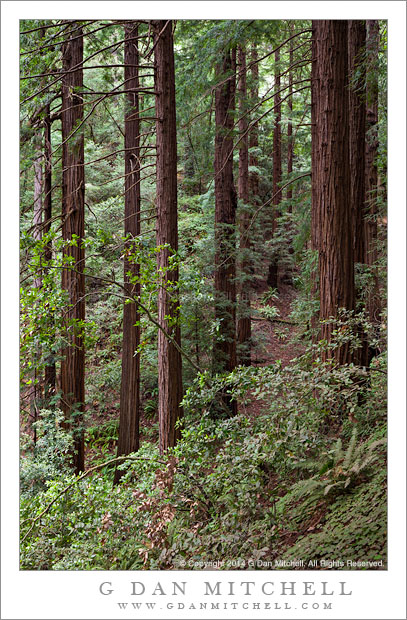
Approximate center of photo:
For the purposes of this article, I used conversion and processing techniques that I would typically use with such a photograph, though I did not take it all the way through my complete post-processing workflow. Among other things, I did apply my typical basic sharpening settings, and I lightened various elements of the photograph in typical ways. I did not apply any correction for barrel/pincushion distortion, CA, or tilt, or perspective. I also did not crop. The photograph was made at 35mm, f/16, ISO 100, and a two second exposure, with the 5DII on the tripod. A slight breeze added some minor motion blur to vegetation. Below are some 100% magnification crops of five sections from the full image:
(Some will correctly point out that diffraction will soften an image slightly at f/16 on a full frame sensor camera. I shot at that aperture here since I was willing to sacrifice some maximum center sharpness in order to increase DOF. With a subject that didn’t require this I might use f/8 or so and the crops might be even a bit sharper.)
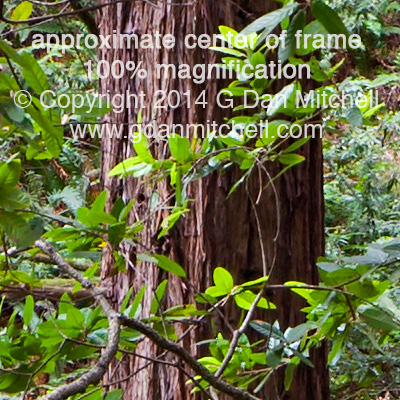
Lower left corner:
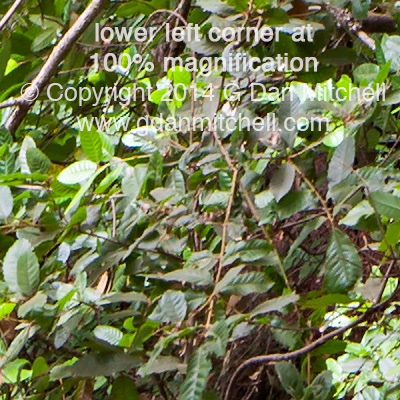
Lower right corner:

Upper right corner:
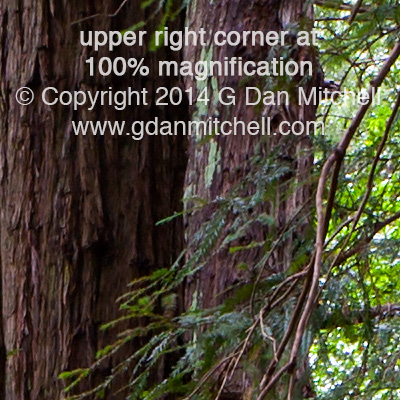
Upper left corner:
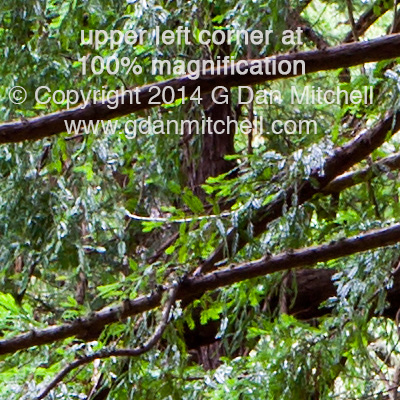
(A “100% magnification crop” is a small section of a larger image, presented so that each pixel of the original is displayed as a full pixel when reproduced on the screen. At 72 ppi screen resolution, these crops represent an image size that would produce a print that is many feet wide.)
Today’s photo of the day, posted just before this post, was made using the new lens. That photograph was shot at 22mm but otherwise in much the same way as the test image above. I’m not sharing any 100% crops of that photograph with this article, but I may share some later on when I have a chance to test tear that image apart.
A few closing thoughts
- Is the image quality of the new lens better than that of the two Canon alternatives? To my mind, the answer to this bottom line question is clearly “yes.” The 16-35mm f/4 L IS directly addresses the most common complaint about the previous Canon ultra-wide zooms, namely that photographers wanted better corner performance.
- What about the older lenses — 16-35mm f/2.8 L and 17-40mm f/4 L? – I believe that the new Canon EF 16-35mm f/4 L IS lens is going to be the best option for a lot of photographers, but I don’t think that it will completely replace the other lenses, each of which has features that will attract some users more than the new lens. The 16-35mm f/2.8 has, obviously, a larger maximum aperture. While the image-stabilization in the new lens compensates for that (and, in fact, more than compensates for it) in situations where handheld camera stability is the concern, the larger aperture does permit a slightly faster shutter speed where subject motion is the issue. For photographers who primarily need an ultra wide for stopped down, small aperture shooting from the tripod, the 17-40mm f/4 lens will remain a good and less expensive option — and one of the lowest-cost L lens entry points along with the non-IS 70-200mm f/4 L. In addition, given the attractions of the new lens, I think that we may see some very attractive pricing on used copies of the other two, so those who search for deals may find some good ones.
- Will Canon introduce an f/2.8 ultra wide with similar image quality? That is a darned good question, and I do not have an answer. It would seem that they would have to since a) Nikon has had a very fine f/2.8 ultra wide lens (which does have some issues) for quite a while, and b) the market for the current Canon f/2.8 ultra wide zoom is likely to contract in response to the new 16-35mm lens.
- What about photographers shooting cropped sensor cameras? That is also a very interesting question. I still think that that the Canon EFS 17-55mm f/2.8 IS lens is likely a better value for cropped-sensor Canon shooters. It has excellent image quality, a larger f/2.8 maximum aperture, a larger focal length range, image stabilization, and a price that is closer to that of the 17-40mm f/4 L. The image-stabilization feature of the new 16-35 f/4 elimates one of those advantages, but the EFS lens still seems like a better bet for cropped-sensor shooters on the other counts.
- This “test “is not comprehensive. Indeed, as I wrote, the basis of this article was mostly a single shooting experience, during which I used the lens the way I would most typically use such a lens — small apertures, working from the tripod, taking advantage of large DOF. I did not “test” the wide open f/4 performance in the corners (aside from my informal handheld test when I received the lens), so I cannot yet say as much about the corner performance at f/4 nor about the IS system. Stay tuned…
Questions? Comments? Observations based on your own experience with this new lens? Please leave a comment below.
- If you are considering a purchase and this post helped you make your decision, please consider purchasing via the links to site-affiliate B&H photography that are found on this page. Your price will be exactly the same, but your purchase helps support this website and my efforts to write and share articles like this one. Thanks in advance! Lenses mentioned in this post:
- Canon EF 16-35mm f/4 L IS lens
- Canon EF 17-40mm f/4 L lens
- Canon EF 16-35mm f/2.8 L II lens
- Canon EFS 17-55mm f/2.8 IS lens (for Canon cropped sensor DSLRs only)
G Dan Mitchell is a California photographer and visual opportunist. His book, “California’s Fall Color: A Photographer’s Guide to Autumn in the Sierra” is available from Heyday Books and Amazon.
Blog | About | Flickr | Twitter | Facebook | Google+ | 500px.com | LinkedIn | Email
All media © Copyright G Dan Mitchell and others as indicated. Any use requires advance permission from G Dan Mitchell.
Discover more from G Dan Mitchell Photography
Subscribe to get the latest posts sent to your email.


hi,
i brought this lens yesterday,i liked this…but
when i using IS,some sounds coming from inside.
is this a mechanical compaint?
thanks.
The image stabilization (IS) system normally makes some noise when it operates — you might hear a soft click when it starts up and then perhaps a gentle whirring sound.
Dan